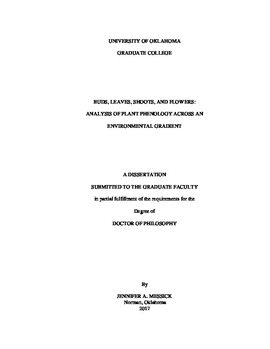| dc.contributor.advisor | Hoagland, Bruce | |
| dc.contributor.author | Messick, Jennifer | |
| dc.date.accessioned | 2017-05-10T14:57:44Z | |
| dc.date.available | 2017-05-10T14:57:44Z | |
| dc.date.issued | 2017-05-12 | |
| dc.identifier.uri | https://hdl.handle.net/11244/50746 | |
| dc.description.abstract | Survival analysis was used to investigate the potential roles of temperature, precipitation, and photoperiod in triggering budburst and leaf-out for Quercus marilandica and Q. stellata. We found a high degree of inter-annual and interspecific variation in budburst and leaf-out dates for both species. Our results indicate that the interaction of temperature, precipitation, and photoperiod had significant influence on the budburst and leaf-out events for both species but in different combinations. A threshold temperature of 5oC was found to be significant in the budburst survival models whereas a threshold temperature of 10oC was not significant. Chilling and warming units of five minute intervals were significant in the budburst models while one hour intervals were not significant. Temperature, precipitation, and photoperiod also all played a significant role in leaf-out models.
Branch position around the tree crown was investigated to determine if position had an influence on budburst and leaf-out times. Branch position around the crown was also assessed for influence on the rate of shoot elongation after budburst occurred.
Budburst date was not found to be influenced by branch position for either species while it did for leaf-out date. Shoot elongation rate also was not influenced by branch position on the tree crown nor was this influenced by precipitation or temperature.
We used herbarium specimens to investigate potential changes in the flowering times for members of the Brassicaceae and Lamiaceae across Oklahoma. We used generalized additive models to assess the influence of climatic variables on flowering across the state and within provisional seed zones. Directional spatial autocorrelation was tested as a measure of flowering synchronicity using the Mantel bearing correlogram. Twenty species, ten in each family, met our criteria to be included in the study. Significant trends in flowering were found for ten species, five in each family. These trends were most often delays in flowering time. The models found varying climatic variables were influential in flowering. The climate variables three months prior to specimen collection were most frequently the significant variables for many of the species. Several species showed some directionality in spatial autocorrelation for flowering then had no apparent directional autocorrelation when subset into seed zone. The directional autocorrelation from the seed zones best represents the direction and relative synchronicity of flowering for these species. | en_US |
| dc.language | en_US | en_US |
| dc.subject | Plant Phenology | en_US |
| dc.title | BUDS, LEAVES, SHOOTS, AND FLOWERS: ANALYSIS OF PLANT PHENOLOGY ACROSS AN ENVIRONMENTAL GRADIENT | en_US |
| dc.contributor.committeeMember | Souza, Lara | |
| dc.contributor.committeeMember | de Beurs, Kirsten | |
| dc.contributor.committeeMember | Greene, Scott | |
| dc.contributor.committeeMember | Purcell, Darren | |
| dc.date.manuscript | 2017-05-04 | |
| dc.thesis.degree | Ph.D. | en_US |
| ou.group | College of Atmospheric & Geographic Sciences::Department of Geography and Environmental Sustainability | en_US |
| shareok.orcid | 0000-0003-0560-659X | en_US |
